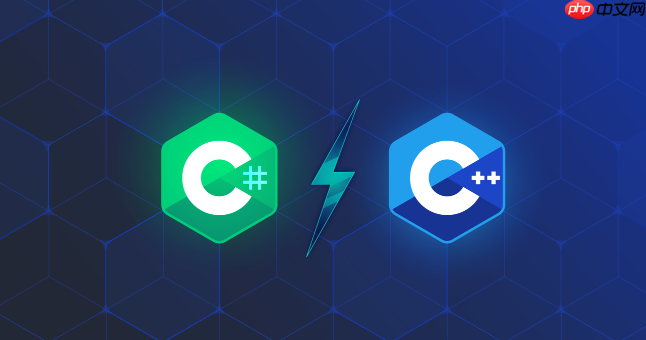减少条件分支可提升C++程序效率,核心是降低CPU预测错误。查表法适用于有限离散输入,位运算优化标志判断,std::min/max简化范围限制,模板元编程在编译时消除分支,多态和设计模式如状态模式、策略模式替代if-else嵌套,SIMD实现并行处理。结合性能分析工具、代码审查、基准测试与编译器优化报告,能有效识别瓶颈并验证优化效果。

减少条件分支,可以显著提升C++程序的运行效率,尤其是在循环和频繁调用的函数中。核心在于避免CPU预测错误带来的性能损失。
解决方案
减少条件分支的方法有很多,选择哪种取决于具体的场景和代码结构。
-
查表法(Lookup table): 当条件分支基于一个有限且离散的输入范围时,查表法是最有效的。创建一个数组或映射,将输入值直接映射到对应的结果。
立即学习“C++免费学习笔记(深入)”;
// 假设输入是0-9的整数,对应不同的处理函数 using HandlerFunc = void (*)(); HandlerFunc handlers[] = { handler_0, handler_1, handler_2, handler_3, handler_4, handler_5, handler_6, handler_7, handler_8, handler_9 }; void process(int input) { if (input >= 0 && input < 10) { // 增加安全性检查 handlers[input](); } else { // 处理非法输入 handle_invalid_input(); } }查表法的优点是速度极快,缺点是需要额外的内存空间,并且只适用于输入范围有限的情况。
-
位运算: 如果条件分支基于位标志的组合,使用位运算可以有效地消除分支。
// 假设 flags 是一个位标志,例如 (FLAG_A | FLAG_B) if (flags & FLAG_A) { process_A(); } if (flags & FLAG_B) { process_B(); } if (flags & FLAG_C) { process_C(); } // 使用位运算优化 void process(int flags) { // 根据不同的位标志执行不同的操作 if (flags & (FLAG_A | FLAG_B | FLAG_C)) { // 避免全0情况 if (flags & FLAG_A) process_A(); if (flags & FLAG_B) process_B(); if (flags & FLAG_C) process_C(); } }位运算的优点是速度快,代码简洁,缺点是可读性可能较差,需要仔细注释。
-
使用
std::min
和
std::max
: 对于简单的条件判断,可以使用标准库中的
std::min
和
std::max
函数。
// 原始代码 if (x < min_val) { x = min_val; } else if (x > max_val) { x = max_val; } // 优化后的代码 x = std::max(min_val, std::min(x, max_val));这种方法适用于简单的范围限制,代码简洁易懂。
-
模板元编程(Template Metaprogramming): 在编译时确定条件分支的结果,从而消除运行时的分支。这通常用于高度优化的库中。
template <bool Condition, typename Then, typename Else> struct conditional { using type = Then; }; template <typename Then, typename Else> struct conditional<false, Then, Else> { using type = Else; }; template <bool Condition, typename Then, typename Else> using conditional_t = typename conditional<Condition, Then, Else>::type; // 使用示例 template <int N> auto process() { using ResultType = conditional_t<(N > 0), int, double>; return ResultType(N); }模板元编程的优点是性能极高,缺点是代码复杂,难以理解和调试。
-
多态(Polymorphism): 使用虚函数和继承,将不同的处理逻辑封装到不同的类中。
class Base { public: virtual void process() = 0; }; class DerivedA : public Base { public: void process() override { // 处理逻辑 A } }; class DerivedB : public Base { public: void process() override { // 处理逻辑 B } }; // 使用示例 Base* obj = (condition ? new DerivedA() : new DerivedB()); obj->process(); delete obj;多态的优点是代码结构清晰,易于扩展,缺点是虚函数调用有一定的性能开销。
-
指令集优化(SIMD): 使用SIMD指令集可以并行处理多个数据,从而减少条件分支的数量。例如,可以使用AVX或SSE指令集。
#include <immintrin.h> void process_simd(float* data, int size) { for (int i = 0; i < size; i += 8) { __m256 vec = _mm256_loadu_ps(&data[i]); // 使用SIMD指令进行并行处理 // ... _mm256_storeu_ps(&data[i], vec); } }SIMD指令集优化的优点是性能提升显著,缺点是代码复杂,需要深入了解硬件架构。
C++中如何避免过多的if else嵌套?
-
提前返回(Early Exit): 尽早处理异常情况,减少后续的嵌套层数。
// 原始代码 void process(int value) { if (value > 0) { if (value < 100) { // ... } else { // ... } } else { // ... } } // 优化后的代码 void process(int value) { if (value <= 0) { // ... return; } if (value >= 100) { // ... return; } // ... }提前返回可以使代码更加扁平化,易于阅读和理解。
-
状态模式(State Pattern): 将不同的状态封装到不同的类中,避免使用大量的
if-else
语句来判断状态。
class State { public: virtual void handle() = 0; }; class StateA : public State { public: void handle() override { // 处理状态 A } }; class StateB : public State { public: void handle() override { // 处理状态 B } }; class Context { private: State* state; public: void setState(State* state) { this->state = state; } void handle() { state->handle(); } }; // 使用示例 Context context; context.setState(new StateA()); context.handle(); context.setState(new StateB()); context.handle();状态模式可以有效地管理复杂的状态转换,使代码更加模块化。
-
策略模式(Strategy Pattern): 将不同的算法封装到不同的类中,避免使用大量的
if-else
语句来选择算法。
class Strategy { public: virtual int execute(int a, int b) = 0; }; class AddStrategy : public Strategy { public: int execute(int a, int b) override { return a + b; } }; class SubtractStrategy : public Strategy { public: int execute(int a, int b) override { return a - b; } }; class Context { private: Strategy* strategy; public: void setStrategy(Strategy* strategy) { this->strategy = strategy; } int executeStrategy(int a, int b) { return strategy->execute(a, b); } }; // 使用示例 Context context; context.setStrategy(new AddStrategy()); int result = context.executeStrategy(10, 5); // result = 15 context.setStrategy(new SubtractStrategy()); result = context.executeStrategy(10, 5); // result = 5策略模式可以灵活地切换算法,使代码更加可维护。
如何分析C++代码中的条件分支性能瓶颈?
-
性能分析工具(Profiling Tools): 使用性能分析工具,例如
gprof
、
perf
或visual studio Profiler,可以找出代码中的热点函数和条件分支。
g++ -pg your_code.cpp -o your_program ./your_program gprof your_program gmon.out > profile.txt
性能分析工具可以提供详细的性能报告,帮助你找到性能瓶颈。
-
代码审查(Code Review): 请同事或朋友审查你的代码,寻找潜在的性能问题和可以优化的条件分支。
代码审查可以发现你可能忽略的细节,并提供不同的优化思路。
-
单元测试(Unit Testing)和基准测试(Benchmarking): 编写单元测试和基准测试,可以验证你的优化是否有效,并防止引入新的性能问题。
#include <chrono> #include <iostream> void benchmark(void (*func)(), const std::string& funcName) { auto start = std::chrono::high_resolution_clock::now(); func(); auto end = std::chrono::high_resolution_clock::now(); auto duration = std::chrono::duration_cast<std::chrono::microseconds>(end - start); std::cout << "Function " << funcName << " took " << duration.count() << " microseconds" << std::endl; } // 示例函数 void testFunction() { // ... } int main() { benchmark(testFunction, "testFunction"); return 0; }
单元测试和基准测试可以帮助你量化性能提升,并确保代码的正确性。
-
编译器优化报告(Compiler Optimization Report): 现代编译器可以生成优化报告,其中包含关于条件分支预测和内联的信息。
g++ -O3 -fprofile-generate your_code.cpp -o your_program ./your_program g++ -O3 -fprofile-use your_code.cpp -o your_program
编译器优化报告可以帮助你了解编译器如何优化你的代码,并提供优化建议。
减少条件分支是C++程序优化的重要手段。选择合适的方法,并结合性能分析工具,可以有效地提升程序的运行效率。





评论(已关闭)
评论已关闭